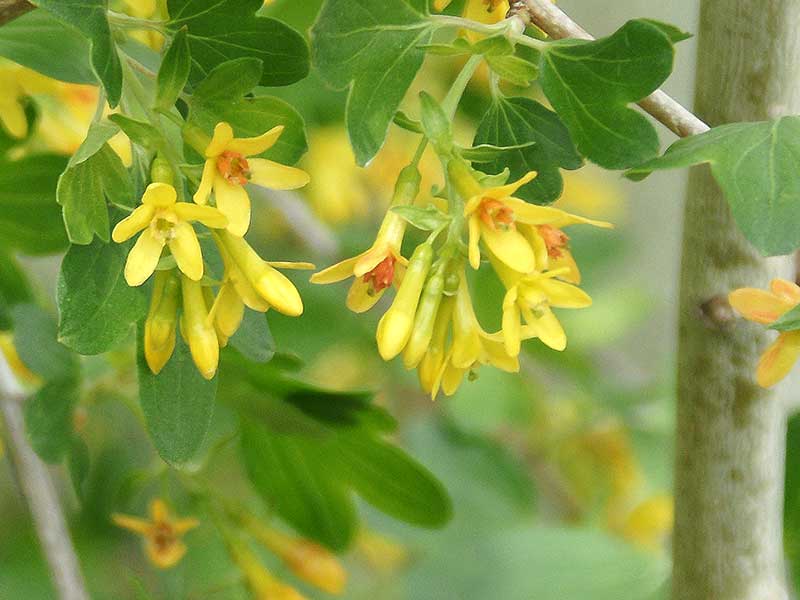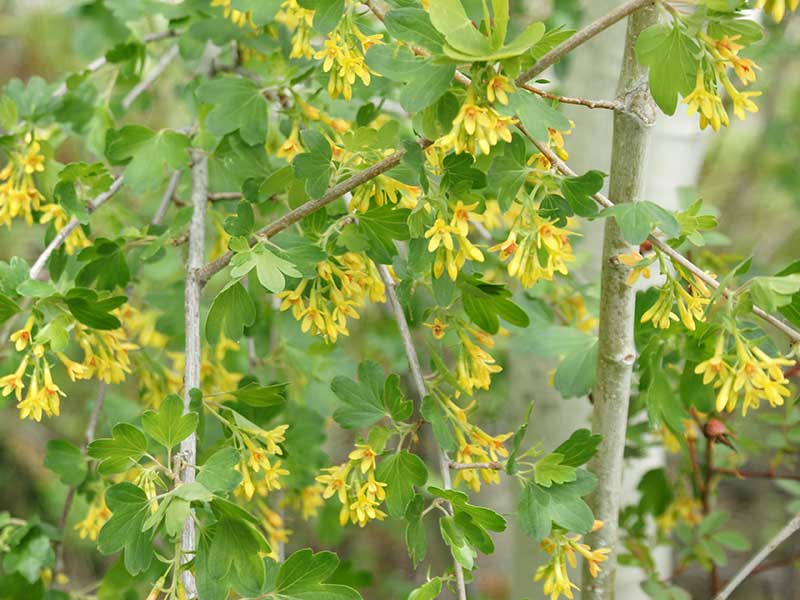Ribes aureum / golden current
- shrub up to 10 feet tall
- spring bloomer, golden yellow flower in clusters
- small, maple-like leaves
- 1/2 inch berries in late summer, golden to black
Also known as: clove currant, pruterberry, buffalo currant
See also: Ribes lacustre / prickly currant
Ribes aureum is a small to medium-sized deciduous shrub, growing up to about 5 feet tall. Although not exceptionally common, it may be found growing in a wide variety of habitats – scrublands, roadside ditches and fencerows, thickets, montane meadows, and streamsides. For a plant often found in wet or moist areas, it is remarkably drought tolerant.
Golden current is immediately visible and identifiable in early spring and late summer. In early spring, it is one of the first to flower. In late summer, the cream and reddish berries stand out. Later on, the red fall coloration is also quite noticeable.
Golden currant flowers are on short, often-drooping racemes, i.e. clusters of up to 15 individuals. They are conspicuously golden yellow and teeny to small – 1/4 to 3/4 inches long. They have a spicy fragrance, like cloves or vanilla, hence the “clove currant” common name. The flowers are tubular and turn orange-ish to violet as they age.
The flowers are a bit unusual, having an elongated (yellow) tube formed by fusion of the petals and sepals. The five petal-like lobes around the outside are actually sepals. The actual petals are yellow to red, and much shorter. The flowers are edible.
The actual golden currants, berries, are only about 1/3 inch in diameter. When ripe, they are amber, to mixed yellow and maroon (or cream and reddish), to black. They are edible but very tart so they are usually cooked with sugar added. They are also very seedy.
The leaves of the golden current are green with 3 (usually) or 5 lobes. They are alternately arranged on non-spiny twigs, maple-like in shape, and between 3/4 and 3 inches long and wide. Each has a few coarse teeth at the ends of the lobes. They turn red in autumn.
Interesting bits – Like other Ribes spp., golden currant is a host for the white pine blister rust fungus which damages or kills those trees. As a result, for 40 years, it was the subject of considerable, but generally unsuccessful, eradication efforts; the program was halted in the 1970s.
Golden currents were an Important seasonal food for indigenous Americans in the west. The berries can be eaten fresh or mixed with meat and dried. They can also be used in jams and jellies. Of course, many animals also eat the fruits and nectar-loving birds, e.g. orioles, may eat the flowers.
The common name, pruterberry, is odd, so I looked that up. Whether it is actually R. aureum, or not depends on whether you ask USDA or the folks around Boardman, Oregon. There it is apparently agreed that it is a cultivar (or something unspecified) developed by John and Vera Pruter, early settlers of the area. They sold the berries and cuttings, and gave their name to the plant.
| Color | |
|---|---|
| Family | |
| Blossom size | |
| Inflorescence size | |
| Inflorescence type | |
| When? | |
| Where? |


